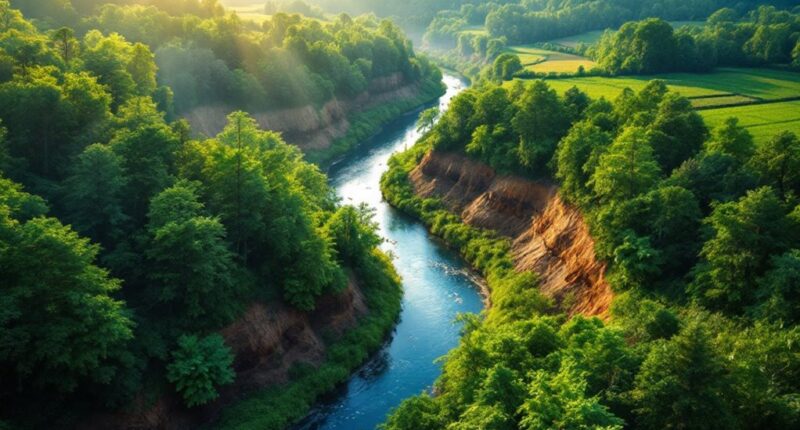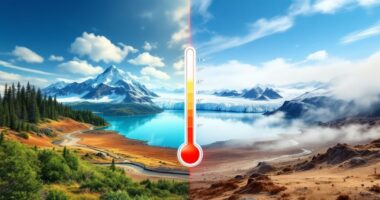Natural capital encompasses the world’s stock of natural resources that support human economies and wellbeing. It assigns dollar values to ecosystem services like clean air and water, traditionally viewed as “free.” At approximately $44 trillion in global economic value, these assets underpin industries from tourism to pharmaceuticals. Businesses increasingly incorporate natural capital into risk management, recognizing that resource scarcity poses financial threats while sustainable practices offer competitive advantages. The conservation of these foundational assets proves essential for our economic future.

While traditional economic frameworks have long overlooked the true value of our planet’s resources, natural capital stands as the fundamental foundation upon which all human prosperity depends. This vast portfolio of Earth’s assets—from bustling forests to mineral-rich soils and clean water systems—isn’t just pretty scenery; it’s the original investment account that keeps paying dividends in the form of ecosystem services. Maintaining high levels of biodiversity conservation is crucial for these ecosystems to deliver their full range of services effectively.
Think of it as nature’s 401(k) plan, but instead of quarterly statements, we get daily benefits like breathable air and drinkable water. The financial stakes are staggering—about $44 trillion of global economic value generation (roughly half the world’s GDP) hinges directly on these natural assets. Yet we’ve been treating this account like an unlimited credit card, making withdrawals without checking the balance.
Industries from tourism to pharmaceuticals are fundamentally nature-dependent businesses, though they rarely list “pollination services” or “genetic diversity” on their balance sheets. Natural capital accounting aims to correct this oversight by giving dollar values to what we’ve traditionally considered “free.” It’s like finally adding up what your generous aunt has been giving you all these years and realizing she’s been bankrolling half your lifestyle.
The World Bank’s Global Program on Sustainability supports this accounting revolution, helping countries understand the true costs and benefits of development decisions. Meanwhile, businesses are discovering that natural capital isn’t just tree-hugger territory—it’s serious risk management. Resource scarcity, regulatory changes, and reputational damage represent real financial threats.
Forward-thinking companies are finding competitive advantages through sustainable resource management and nature-based solutions. Investment in sustainable farming methods that reduce water usage represents one promising avenue for protecting natural capital while maintaining productivity. The idea of viewing conservation as investment gained significant momentum when Robert Costanza’s study in 1997 valued ecosystem services in the trillions, exceeding global GDP at that time. The threats to our natural capital—climate change, biodiversity loss, environmental degradation—rank among our gravest global risks. Yet strategies exist for preservation: sustainable management practices, conservation investments, and collaborative protection efforts between governments and businesses.
Ultimately, preserving natural capital isn’t just about saving trees and bees—it’s about maintaining the foundational assets that make human economies possible. Our economic house of cards cannot stand without nature’s solid foundation beneath it.
Frequently Asked Questions
How Is Natural Capital Measured and Quantified?
Natural capital is measured through multiple complementary approaches.
Scientists quantify ecosystem extent using mapping and remote sensing, while evaluating condition through biodiversity surveys and health indicators. They track natural capital stocks like forests and minerals using standardized accounting methods.
Ecosystem service flows are measured through biophysical models and economic valuation techniques.
International frameworks like the UN’s SEEA and the Natural Capital Protocol provide standardized methodologies for consistent quantification across different contexts.
Can Natural Capital Be Restored Once Depleted?
Natural capital can indeed be restored, though with important caveats. Many ecosystems demonstrate remarkable resilience when given time and proper management.
Forests regrow, wetlands recover, and soil health rebuilds through regenerative practices. However, restoration timelines vary dramatically—some resources regenerate quickly while others may take centuries.
Certain damages, once past critical thresholds, prove irreversible. Climate change further complicates restoration efforts, adding uncertainty to recovery trajectories despite advances in restoration ecology.
Who Bears Responsibility for Natural Capital Management?
Responsibility for natural capital management falls on multiple shoulders.
Governments establish protective policies and regulations, while businesses assess their dependencies and impacts.
Financial institutions integrate natural capital into investment decisions, and civil society raises awareness and holds others accountable.
No single entity bears complete responsibility—effective stewardship requires a collaborative approach where each stakeholder plays their distinct role in the complex ecosystem of natural resource management.
How Do Indigenous Perspectives Inform Natural Capital Valuation?
Indigenous perspectives transform natural capital valuation by rejecting the simple price-tag approach.
These worldviews recognize nature’s cultural and spiritual dimensions alongside material benefits. Indigenous communities view ecosystems holistically, emphasizing reciprocity rather than extraction.
Their traditional knowledge highlights services that Western frameworks often overlook – like cultural identity and sacred connections.
This perspective shifts valuation from “what can we take?” to “how do we maintain balance?” – a profound reimagining of what truly constitutes value in natural systems.
What Technological Innovations Help Monitor Natural Capital?
Modern technology has revolutionized natural capital monitoring.
Satellites detect individual animals and illegal fishing vessels, while platforms like Google Earth Engine map ecosystems.
Drones equipped with hyperspectral imaging spot early signs of seagrass disease.
AI enhances multi-sensor mapping and predictive modeling for conservation outcomes.
Environmental DNA sampling offers non-invasive biodiversity assessment through simple water filters, while bioacoustic devices track wildlife populations by recording and analyzing sounds in ecosystems.









